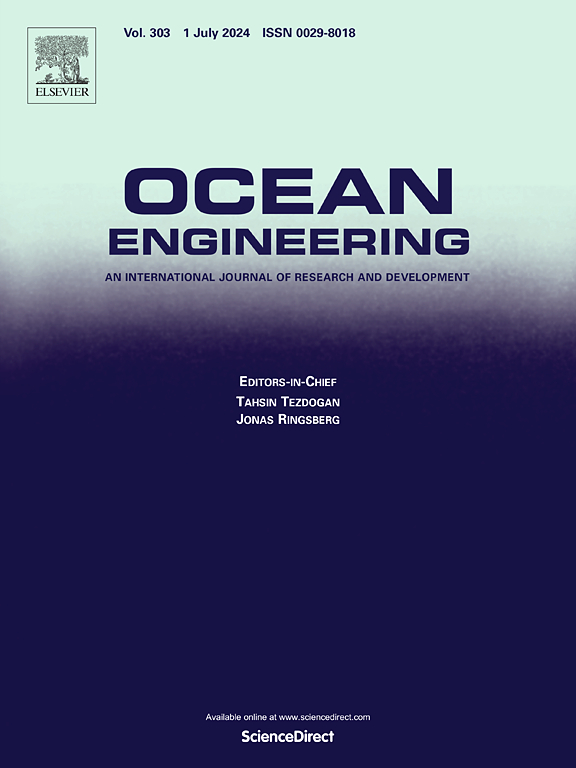A novel two-way coupled algorithm of time-domain hydro-elastic analysis for free-end offshore floating structures using inertia relief method
IF 4.6
2区 工程技术
Q1 ENGINEERING, CIVIL
引用次数: 0
Abstract
This study proposes an efficient two-way coupling algorithm between fluid and structure domains, integrating a Boundary Element Method (BEM) solver for potential fluid analysis with a Finite Element Method (FEM) solver for shell theory calculations. To represent realistic physical phenomena without artificial boundary conditions, an inertia relief method is implemented at the fluid-structure interface. The fluid domain analysis is conducted through a Fortran-based numerical code that calculates incident, diffraction, and radiation potentials, while ABAQUS serves as the FEM solver for structural analysis with subroutine interfaces. The algorithm introduces an element-based calculation approach, where frequency-dependent hydrodynamic properties, including pressure transfer functions, added mass, and linear damping coefficients, are pre-processed through the subroutine interface. These properties are transformed into time-dependent coefficients using the expanded Impulse Response Function (IRF) theory, incorporating added mass at infinite frequency, retardation functions, and wave exciting pressures. The coupling mechanism facilitates continuous communication between two domains through the exchange of motion and force vectors at each time step, enabling efficient representation of fluid-structure interactions. The validation process consisted of three phases: (1) verification of the expanded IRF theory by comparing element-based calculations with conventional methods; (2) comparison of rigid body motion Response Amplitude Operators (RAOs) with commercial software ANSYS AQWA and RADIS (Radiation and Diffraction Solver, developed by Korea Maritime and Ocean University); and (3) validation of elastic responses through experimental data comparison, focusing on vertical displacement RAOs. The comparisons showed good agreement across various wave heading angles and frequencies, with minor discrepancies observed at the longitudinal edges of the model, which were primarily attributed to the simplified drift-control system in the experimental setup and scale effects. The comprehensive validation demonstrates the reliability of the proposed method within the tested parameter ranges. Regarding computational efficiency, the method requires approximately 5 times real-time processing (i.e., 1 s of simulation requires 5.16 s of computation using a single CPU core), making it practical for engineering applications. Additionally, the validated method was applied to a large-scale Floating Offshore Wind Turbine (FOWT), incorporating mooring system and aerodynamic loads sequentially. Results were compared with OpenFAST (open-source code) and OrcaFlex (commercial software) to verify the analytical reliability. While differences in transient section and low-frequency motion were observed due to variations in mooring system analysis methods and aerodynamic load interaction algorithms, these aspects warrant further investigation in future work. Previous studies have demonstrated limitations of the inertia relief method near resonance frequencies in aerospace and automotive applications. While existing research primarily focused on static analysis, this study successfully extends the method to dynamic systems through the proposed algorithm. This finding extends the applicability of the inertia relief method beyond its conventional usage, particularly in hydroelasticity analysis. The balance of accuracy and computational efficiency, combined with the ability to predict hydroelasticity behavior without artificial boundary conditions, makes the proposed method particularly valuable for analyzing floating structures in offshore environments, especially during early design phases requiring multiple iterations and load case evaluations with high accuracies.
求助全文
约1分钟内获得全文
求助全文
来源期刊

Ocean Engineering
工程技术-工程:大洋
CiteScore
7.30
自引率
34.00%
发文量
2379
审稿时长
8.1 months
期刊介绍:
Ocean Engineering provides a medium for the publication of original research and development work in the field of ocean engineering. Ocean Engineering seeks papers in the following topics.
 求助内容:
求助内容: 应助结果提醒方式:
应助结果提醒方式:


